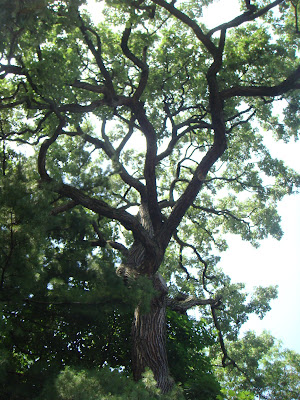As you may have noticed, I'm a bit of a tree geek. Let's face it - I'm an uber tree geek. They fascinate me - the roots, trunks, branches, buds, leaves - all of it. I can talk about trees for days. I can identify them at 60 miles an hour. My family graciously puts up with me and refuses to play Name That Tree. Sometimes they are No Fun.
My favorite tree is the elm. Katsura, beeches, and oaks run a close second, but elm is my doomed love affair. I grew up in a suburb with elm lined streets creating leafy tunnels and squirrel highways. I watched them felled year after year by Dutch elm disease. I can give you the history of Dutch elm and the elm leaf beetle that is the disease vector, but I won't. It was identified in Holland, thus the 'Dutch' part of the name. There is NO type of tree called Dutch elm! I once came across a novel where the protagonists strolled under Dutch elm trees. I believe I threw the book against a wall in disgust.
Anyway, I attended a lecture years ago given by Dr. George Ware at the Morton Arboretum on elms. Dr. Ware was one of the preeminent elm scientists and is responsible for many of the disease resistant cultivars now on the market. He lived and breathed elms and still came into the Arb even though he's retired. He asked the class if anyone wanted an elm seedling as he was testing some new saplings grown from seeds collected in China by Dr. Kris Bachtell. Oooo! A free elm! How could I resist? It didn't matter that I was living in an apartment in Evanston at the time. My in-laws graciously planted it in their yard until the day we could buy a house. It's an
Ulmus davidiana or David elm, thus my mother-in-law christened it Dave. He was only as big around as my thumb and very cute. Yes, trees can be cute. Shush.
Fast forward two years, and there we are, new homeowners. Time to transplant! However, Dave, being an elm, had grown. A lot. Now he was two inches in diameter (or to be technical, two inch caliper DBH (diameter at breast height)) and quite a bit taller. Hmmm. Some shovels, burlap, as well as me, my husband, and father-in-law set to work. Hours later after much digging, hacking, piano wire, and cursing, we had managed to wrestle Dave from the ground. Guess what? Elms can have a tap root. By the time we'd loaded him into the family minivan, the root mass was pretty dodgy looking and losing soil. Still, we planted him in the front yard (a shade too deeply in hindsight), watered him in and hoped.
Eight years later, Dave is lovely. He is gorgeous. He's survived major pruning, cicadas, and the neighbor kids. He is well on the way to being a stunning, vase-shaped shade tree. Birds nest in his branches each year. This year, the neighbors' elm succumbed to Dutch elm due mainly to shoddy pruning practices. If you have elms, don't prune them in July, even if the branches interfere with your fire pit. Elm leaf beetles are attracted by open wounds and stress. Only prune elms in winter when insects are dormant. We are watching Dave like hawks, but so far, no signs of it.
If you are going to transplant trees, do it as young as possible. Once they are at the two to three inch caliper DBH, it gets much more challenging and requires more than one person and the proper tools. Call your friends and buy them beer and pizza. You can find landscaping companies with tree spades (Picture a huge three bladed machine that can stab down and lift a whole root ball. They are really cool!), but it is thousands and thousands of dollars to move large trees. Trees should be planted so that the root flare - where the trunk starts to flare into the major roots - is at the soil line. The soil that you dug out of the hole goes right back in. Trees will adapt to where they are growing without major amendments. Plants are stubbon! They really want to survive!
Here is Dave in his 2009 fall glory. Isn't he cute?













































